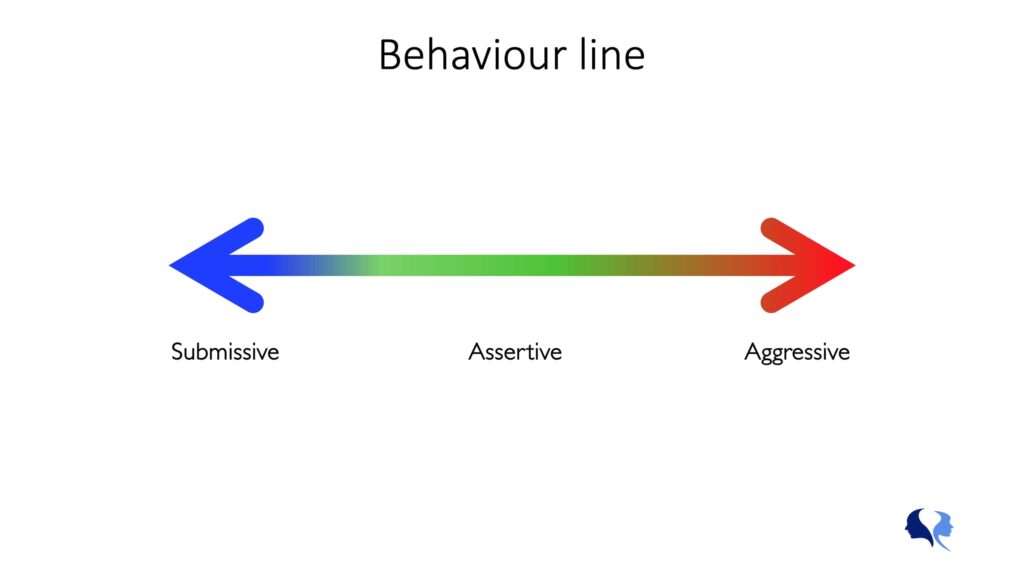
Do you often say yes when you want to say no? Do you struggle to express your opinions or stand up for yourself in difficult situations?
If you’re sitting relentlessly trying to keep yourself from admitting it, knowing that you, in reality, should add a resentful nod, don’t worry – you’re far from the only one.
Being the “assertive one” isn’t always a given.
Silver lining?
Assertiveness is a skill that can be developed and improved over time.
During our Crew Resource Management courses and Human Factors courses, we continuously focus on providing our participants with the tools to become assertive in their work- and private lives.
In this article, we’ll explore what it means to be assertive, why assertiveness is a key skill, and provide some simple tools on how to be more assertive.
Discover all our topics on training techniques.
Assertiveness is the ability to express your thoughts, feelings, and needs directly and appropriately while also understanding and respecting the thoughts, feelings, and needs of others.
It’s a balanced communication style between submissive (being too passive) and aggressive (being too confrontational).
During training, I typically refer to three dominant behaviours or communication styles:
Before we dive into how we work with these in our training, let’s explore what each of these behaviours means.

We can typically characterize submissive behaviour as shy or overly easygoing. Being submissive (or exhibiting submissive behaviour) means that “I’ll just go with whatever the group decides” is your motto.
You do everything in your power to avoid conflict. While, I admit that avoiding conflict – is not necessarily a bad trait. But when you’re neglecting your thoughts and feelings to please others, you will also allow others to disregard those thoughts and feelings.

At the risk of repeating myself, I’ll keep this one short. Being assertive means sharing and clearly expressing your feelings and thoughts. It means you can listen to others while not being afraid to speak up.

Behaving aggressively means that you might come across as a bully. You ignore the needs of others and exclude their feelings and opinions from your decision-making.
While it may seem that being aggressive is the yellow brick road to getting what you want, this is not always the case – in fact – it’s rarely the case. Being aggressive weakens trust and completely erases the possibility of creating synergy within a group context.
During our Crew Resource Management courses, we typically refer to our so-called “behaviour line.”

In training, we use this model to better understand the three dominant behaviours (submissive, assertive, and aggressive). Here, we allow participants to reflect and discuss how to characterize each behaviour.
We typically get answers like this:
[picture]
We then ask our students: Why do you think it is a gradient line?
And no, the purpose is not to test our students’ willingness to join Jeopardy but to highlight their understanding of what it means to exhibit either of these three dominant behaviours.
The correct answer is actually quite simple.
A person cannot be 100% aggressive or 100% submissive – depending on your day, how you feel, and your situation, you might move towards different places on this behaviour line.
Let’s pretend that you’re joining me in one of our courses, and after about a (highly inspiring and learning-packed) hour, it’s time for a break. So I tell you, “Okay, let’s take a break – please leave the classroom”,… and you don’t leave, so now I start shouting at you, “LEAVE THE CLASSROOM.”
In this scenario, that was me showing aggressive behaviour.
Now imagine you are a passenger on a flight, with me as your pilot, and as we taxi onto the runway, a sudden fire bursts. So I start shouting, “LEAVE THE AIRPLANE.”…
Where on the behaviour line would you place me then?
If your first thought is not, “Wow, that belongs to the assertive part of the line”, and your second thought “What a complete badass”, – I’m not sure what to say.
While I’m shouting in both scenarios, how my behaviour is perceived by others will have changed.
Another dimension we must consider with this behaviour line is the “behaviour” elements.
We exclusively focus on behaviour when discussing submissive, assertive, and aggressive.
Why?
That I’m behaving aggressively in one situation doesn’t necessarily mean I’m an aggressive person. But if you try to take the last Snickers bar at the supermarket counter, you’ll experience aggressive behaviour.
While personality is something static that we cannot change, our behaviour is.
So when we talk about “how to become assertive”, this is not about being born an assertive person, but about how well we are in training ourselves in being on the “assertive” part of the behaviour line.
Becoming assertive isn’t just a nice-to-have skill; it’s an essential tool for personal and professional growth.

Let’s look at some of the most important reasons:
1. Improved communication: Assertiveness enhances your ability to communicate effectively. When you express your thoughts and feelings clearly and respectfully, others are more likely to understand you, leading to fewer misunderstandings and conflicts.
2. Enhanced relationships: Assertive individuals tend to have healthier and more satisfying relationships. By respecting your own needs and boundaries while also respecting those of others, you build trust and create an atmosphere of mutual respect.
3. Increased self-esteem: You gain greater self-worth as you become more comfortable expressing your opinions and standing up for yourself.
4. Stress reduction: Submissive individuals often accumulate stress by suppressing their feelings and needs. On the other hand, aggressive individuals may experience stress due to conflicts. Assertiveness helps you manage stress by addressing issues proactively and constructively.
5. Conflict resolution: Becoming assertive equips you with the tools to resolve conflicts peacefully. Instead of avoiding or escalating disputes, you can address them directly, seeking mutually beneficial solutions.
6. Better decision-making: Assertive individuals are more likely to voice their opinions and contribute to decision-making processes. This leads to more well-rounded and informed choices in personal and professional settings.
7. Resilience: Assertiveness is a key component of emotional intelligence. When faced with adversity, you’re better equipped to cope and adapt, as you have the communication skills to seek support, express your feelings, and problem-solve effectively.
8. Personal growth: Developing assertiveness is a journey of self-discovery and personal growth. It encourages you to step outside your comfort zone, face challenges, and learn from your experiences.
Learning how to be more assertive will empower you to communicate effectively, build better relationships, reduce stress, advance your career, and grow.

In 1977, the deadliest aviation accident in history occurred when two Boeing 747s collided on the runway at Los Rodeos Airport in Tenerife.
The primary cause?
The lack of assertiveness amongst the flight crew.
The commander on one of the Boeing’s chose to disregard the opinions and concerns of his first officer and flight engineer, who tried to advise the commander that they had not received take-off clearance from the air traffic controller. After being reprimanded by the commander, they chose to stay silent. As a result, the commander continued take-off and crashed into another aircraft that had just landed on that same runway.
583 people were killed.
Today, we’ve come a long way in understanding the impact of training assertiveness in pilots, cabin crews, air traffic controllers and aviation professionals. Yet, we still see accidents and incidents happen due to the lact of assertiveness amongst crew.
Addressing the issues with submissive or aggressive behaviour and vice versa, the benefits we can reap when exhibiting assertive behaviour still need to be heightened. Crew Resource Management Courses must become even more specific in providing the necessary tools to establish effective communication, decision-making and conflict resolution for maintaining flight safety.
Training to become more assertive involves a combination of educational methods and practical exercises – and no size fits all. Here are some of the tactics you may use to develop your assertiveness skills:

1. Self-awareness: Start by understanding your current communication style and recognizing situations where you tend to be submissive or aggressive.
2. Practice active listening: Effective communication begins with listening. Make a conscious effort to listen actively and attentively to others.
3. Use “I” statements: Instead of blaming or accusing, use “I” statements to express your feelings and needs. For example, say “I feel…” rather than “You make me feel…”. You’ll find that it’s tough to argue with how YOU feel. Only you can truly know that.
4. Set boundaries and practice saying “no”: Clearly define and communicate your boundaries to others. If you struggle turning down requests, try saying “no” more often. I know, easier said than done.
5. Manage emotions: Learn to manage your emotions in challenging situations. Take deep breaths, stay calm, and express yourself without hostility.
6. Use body language: Communication isn’t just verbal. In fact, we communicate at all times – even when we don’t think about it. Ever heard the expression “If you feel it, you will reveal it”. This is one of those “fake it till you make it situations”. Try to express confidence in your body language. Keep an upright posture, make eye contact, don’t cross your arms or legs, etc.
Assertiveness is about finding a balance between submissive and aggressive, allowing you to communicate effectively and build healthier relationships. It’s a skill that can be developed with dedication and effort.
As the importance of assertiveness in our daily lives increases, it is crucial for industries to adapt their training methodologies. This entails not only focusing on technical skills but also on non-technical aspects, such as developing crew members’ ability to display assertive behaviour.
Dive into our insightful and informative articles that will help you explore more and get ahead of the competition.
© 2024 NaviMinds – Designed by Aveo web&marketing